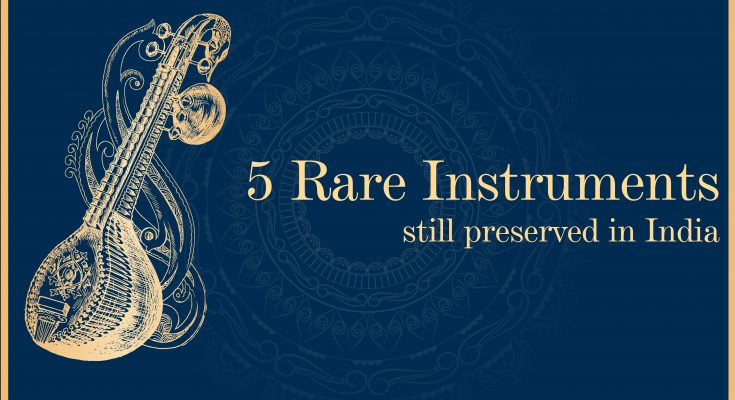The Indian subcontinent is home to varied and diverse cultures that subsequently contributed to a variety of art forms to the table. In fact, this very diversity is responsible for the creation, development (over nearly thousands of years) and eventual loss of these instruments to obscurity, so much so that eventually, these instruments are rarely heard after a few centuries.
The eventual obscurity of such rare instruments, however, can never hide the brilliance of their sounds, created through the finesse of their build.
In India, musical instruments are often associated with divinity- “The Instruments of Gods!” Like the Bansuri (Flute) of Lord Krishna, Veena (similar to Harp) of Goddess Saraswati and of course, the fabled Damru (small, two-headed drum) of The Destroyer, Shiva.
But of course, these are instruments that almost every person who has spent their life on the Indian subcontinent has at least heard of. India, however, is an ocean of tacit musical instruments that have still not found their way in textbooks.
Let us discuss some of those rare musical instruments that we’re sure you may never have heard of:
1. Yazh
The Yazhal is a stringed invention made of wood and metal. The strings run from the angled ebony necked to a boat-shaped arrangement, skin-covered resonator and an ebony stem. Yazh is a musical masterpiece from South India. It was assembled to its final form nearly 2,000 years ago in present-day Chennai, Tamil Nadu.
This highly elusive piece of folk art is the ancestor of modern-day Veena. It has a religious significance in South India, appearing numerous times in classic Tamil literature and tales of distant kingdoms. Yazh can also be found in temple sculptures and has been mentioned a number of times in the lyrics of Thiruvalluvar, the 200 BC Tamil poet.
Other admirers of the instrument include Seevaga Sindhamani and Periya Puranam.
2. Pepa
The Pepa is a wind instrument where a reed pipe is connected to a Buffalo horn. There are 5 or 6 holes if it is bamboo type. There has been increasing use of bamboo or wood as an improvisation to the buffalo horn. It is also called pempa, pepati, singra and xuri. It has its roots in ancient China and Tibet where it was used for religious rituals.
Pepa originates from Assam in East India and was first introduced by buffalo herders. This musical instrument is used to adorn the folk and cultural beauty of the tribes during Bohag Bihu celebrations (Assamese new year) by adding a seasoning element to the dancing symphony.
3. Sursingar
Sursingar is known for its antiquity and has a resemblance to the Sarod. The only difference between the two is Sursingar is larger and produces a deeper sound. This instrument was extensively used during the 19th and 20th centuries. It is an improvement of the Dhrupad-Rabab that has more or less disappeared today.
The first Sursingar was made by Ali Akbar Khan with wood. The gourd is responsible for the sound-producing mechanism, and it’s attached to a hollow wooden handle. It has 4 main strings and 4 metrical drones. It is best to play music in Hindustani style Dhrupad.
Sursingar is capable of rendering low sustained pitches and sweet notes that are high in pitch. The instrument is well received in the world and in no time gained popularity in northern parts of the country.
4. Algoza
Algoza has its genesis in 7500 BC in Mesopotamia. Over time, it reached Iran and then subsequently, North-western India (Present-day Pakistan). In Southeast Asia, the instrument is cherished by Baloch, Saraiki, Sindhi, Kutchi, Punjabi and Rajasthani folk musicians.
The configuration of Algoza is similar to a flute. It is a conjoined figure of 2 bleak flutes, one for melody and the other for drone.
The construction has various approaches like the flutes are either physically joined together or merely tied with a string.
Occasionally one flute comprises 6 to 7 holes for melody and the other one is just for the drone, whereas sometimes both the flute have an identical arrangement of holes.
The musicians play it by using 3 fingers on each side. Sound is induced by breathing into it rapidly. This creates a bouncy rhythmic tone.
5. Ravanhatha
This instrument has a Hindu mythological significance and is believed to have been introduced by Lord Hanuman after the victory of Rama. It gets its name from King Ravana of the Hela community when the instrument was seemingly played for the first time.
The structure matches with the modern-day violin. It is a bowed string instrument, where the base is made of coconut shell and covered in goat hide. A stick, commonly called dandi, made from Bamboo, is attached to the shell. At last, it has bells attached along with the towering bow. This instrument is still used in Rajasthani folk music.
In medieval times the Ravanhatha was patronized by royal families as it was the foremost instrument learned by the princes. In modern times this instrument is being revived by Sri Lankan composer and violinist, Dinesh Subasinghe. The European experimental folk band ‘Heilung’ also plays the instrument.
These are some of the instruments that remain firmly rooted in the hierarchy of Indian music. Even though these instruments haven’t achieved mainstream recognition, they are imbued with every aspect- serenity, nobility, the rich background, and the attached names of historic instrumentalists- that a brilliant musical instrument deserves.








